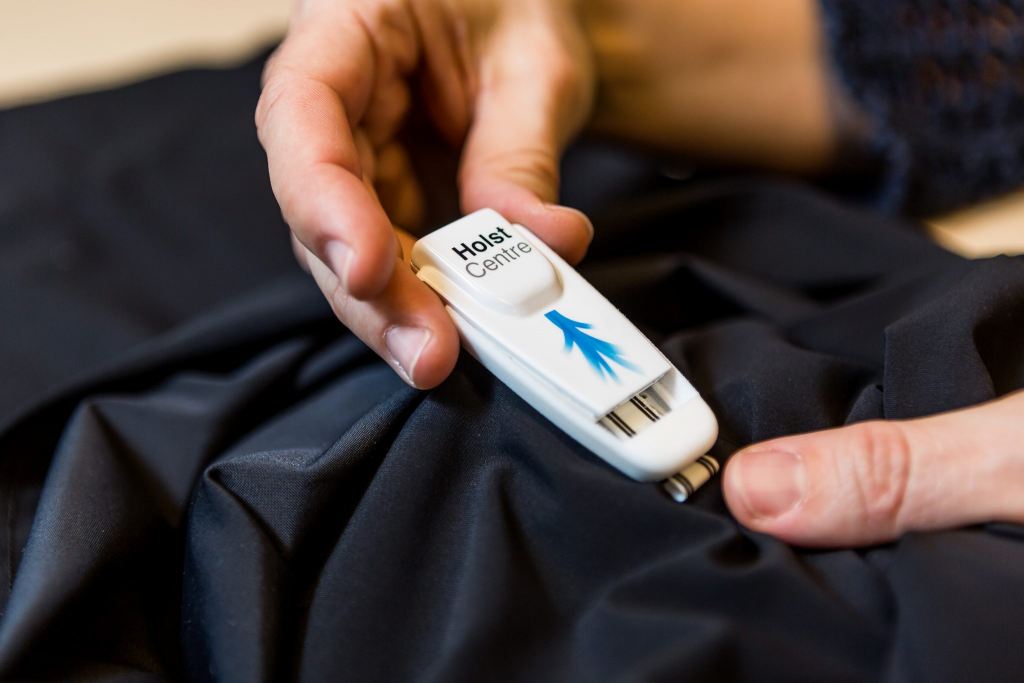

Finally a smart wearable that’s really wearable – and super smart. Researchers from Holst Centre – an open innovation initiative by imec and TNO – have developed a prototype smart shirt that integrates imec’s validated medical-grade electrocardiogram (ECG) monitoring with breathing rate and breathing depth. The use of state-of-the-art printed electronics technology offers complete freedom in design and optimization of printed sensors and electronics, being as thin as 60 µm and up to 100% stretchable.
The properties of the electronics thereby become similar to those of textile, allowing unobtrusive integration. The design can be adapted for a variety of applications. For example patient monitoring in hospitals, home care, elderly care but also for sports. The shirt currently makes a tour around Germany: it is on display at LOPEC in Munich, Germany, until March 30 and will be shown at MedTec Europe April 4-6 2017 in Stuttgart and IDtechEx Europe May 11-12 2017 in Berlin.
The new demonstrator is the third generation of vital sign monitoring shirt created with Holst Centre’s smart clothing integration platform. It continuously measures the wearers’ electrocardiogram (ECG), respiration and motion using imec’s wireless ultra low power multi-sensor data acquisition chip with efficient motion artefact reduction that can share the data via a wireless BTLE system to a smartphone. The developers say the shirt could help to get patients home from hospital sooner by enabling high-quality cardiac monitoring at home and could replace today’s cumbersome Holter monitors. Moreover, the design of the shirt and its electronics can be easily tailored for best electrode contact to skin. This is important to further suppress motion artefacts which are depending for instance on the type of movements typical in different sports. Therefore printed electronics allows maximising performance of both electronics and thereby the users for specific athletic and fitness applications.
Unlike existing heart monitoring clothing, Holst Centre’s smart shirt uses compact and distinct dry electrodes rather than a chest band, making it more comfortable to wear. These electrodes are produced using screen-printable, electrically conductive inks from DuPont, which allows their shape to be optimised for maximum skin contact for strong signal resolution and monitoring performance. The detachable sensor module is also much smaller and lighter (dimensions of 50 by 30 by 10 mm and 12 grams only) than previous generations, again making the shirt more comfortable to wear at all times. The shirt can operate for up to two days on a single battery charge because of the low-power sensor and radio electronics. The mechanical properties and encapsulation are engineered for reliability in the laundry process. With Holst Centre technology a washability of 25 cycles in domestic laundry can be achieved thereby complying with market requirements.
The developers say the shirt could help to get patients home from hospital sooner by enabling high-quality cardiac monitoring at home,
“The new vital signs shirt demonstrator shows how printed electronics can truly improve lives, in this case by enabling continuous and precise monitoring of clinical-grade, biometric data from the comfort of one’s home.” said Kerry Adams, printed electronics market segment manager, DuPont. “We are proud to enable this kind of innovation with our stretchable electronic inks and look forward to our continued participation in Holst Centre’s printed electronics development program.”
“As a designer, the technology platform from the Holst Centre ecosystem is great to work with. You are completely free to design any kind of garment and application you want to, and know that the designed electronics will be easily integrated as part of the normal manufacturing process,” said the shirt’s designer Marina Toeters from by-wire.net.
The underlying technology has been proven in previous generations of the vital signs shirt and numerous health patch demonstrators from Holst Centre and imec. It is also fully compatible with standard garment manufacturing processes: the electrodes can be laminated to any garment as the final stage of production. Holst Centre is looking for more partners to take the smart vital signs shirt to market and develop the technology for other applications.


